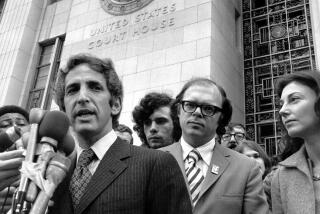Edward Snowden shows evolution of smuggling secrets
- Share via
WHITMORE VILLAGE, Hawaii — Sure, Edward Snowden just used a simple thumb drive to smuggle classified information out of the National Security Agency.
But one look at the sprawling NSA compound where he is believed to have worked in the mountains of central Oahu — with its chain-link fences and barbed wire, massive entrance gates and “Keep out” signs — raises the question of how even a trusted employee with a high-level security clearance could sneak out even an innocuous piece of equipment.
The hulking tan building was dedicated with great fanfare in January 2012, a $358-million project that the NSA boasted in a news release would “help to further integrate national security efforts.” The Capt. Joseph J. Rochefort Building replaced a World War II facility nicknamed “the Tunnels” for its warren of underground work space.
The building’s mission, according to the NSA, was to “provide cryptology professionals with the tools necessary to better access and collaboratively interpret data from a broad variety of sources at various classification levels. Moreover, its enhanced capabilities will augment work that will still be carried out in the original center — eliminating physical, virtual, and other barriers to information sharing.”
What they didn’t know at the ribbon-cutting ceremony was with whom information on that classified program would be shared — the public at large, thanks to Snowden’s stated desire to spark debate about U.S. phone and online surveillance of private citizens.
Stealing classified material has come a long way since 1945, when an American communist named Lona Cohen smuggled Manhattan Project atom bomb secrets out of Los Alamos in New Mexico in a tissue box and spirited them off to her Soviet handlers.
During the Cold War, spies used tiny cameras to copy military plans, secret bugging devices in sewer lines and lamps, and a host of other James Bond and Maxwell Smart gizmos to steal secrets from military bases, government offices and other supposedly secure locations.
Not every case was so high-tech. Robert Hanssen, a senior FBI official who spied for Soviet and then Russian intelligence services for 22 years, was finally arrested in 2001 after he taped a sealed black garbage bag full of classified material to the underside of a wooden footbridge in suburban Virginia. Hanssen was caught only when a Russian official betrayed him.
Like Snowden, he was an insider, able to get into classified facilities without suspicion — and then take documents out.
Patrick Bratton, director of the diplomacy and military studies program at Hawaii Pacific University, said self-styled “whistle-blowers” are harder to ferret out than spies.
“With someone committing espionage, there’s another person to track and another degree of communication,” Bratton said.
“If you, on the other hand, decide to take classified information and give it to the press, you decide it on your own,” Bratton said. “On paper there’s nothing there. No country is communicating with you. There’s no extra money in your bank account … not a lot of outside ways you can predict that it will happen.”
One example is the case of Benjamin Pierce Bishop, another military contractor with a high-level security clearance. His saga is currently unfolding here in Hawaii, where the defense industry is second only to tourism in its impact on the local economy.
Bishop, 59, a retired Army officer who was working as a civilian contractor at U.S. Pacific Command in Hawaii, is charged with giving top-secret information to someone described in court documents only as “PERSON 1,” an unnamed Chinese national 32 years Bishop’s junior with whom he was having “an intimate, romantic relationship.”
In a criminal complaint filed in March, Bishop is accused of sending emails with classified information to the graduate student after they met at a conference on international military defense.
During telephone conversations tapped by law enforcement officials, he allegedly interspersed sweet nothings with “classified national defense information, regarding planned deployment of U.S. strategic nuclear systems, as well as the ability of the U.S. to detect low- and medium-range ballistic missiles of foreign governments.”
Bishop was arrested, but has not yet been indicted.
PERSON 1 has not been arrested and is residing in the U.S. on a student visa, according to the court papers filed in March.
More to Read
Sign up for Essential California
The most important California stories and recommendations in your inbox every morning.
You may occasionally receive promotional content from the Los Angeles Times.











